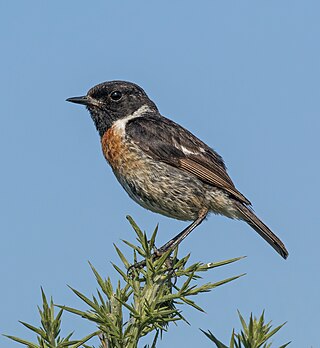
The Canary Islands stonechat, also known as the Fuerteventura stonechat or Fuerteventura chat, and formerly known as the Canary Islands chat due to its once widespread distribution on the Canary Islands, is a sedentary resident bird found only on the island of Fuerteventura where it is known as the Caldereta.

Nopal is a common name in Spanish for Opuntia cacti, as well as for its pads.

The pied bush chat is a small passerine bird found ranging from West Asia and Central Asia to the Indian subcontinent and Southeast Asia. About sixteen subspecies are recognized through its wide range with many island forms. It is a familiar bird of countryside and open scrub or grassland where it is found perched at the top of short thorn trees or other shrubs, looking out for insect prey. They pick up insects mainly from the ground, and were, like other chats, placed in the thrush family Turdidae, but are now considered as Old World flycatchers.

Saxicola, the stonechats or chats, is a genus of 15 species of small passerine birds restricted to the Old World. They are insectivores occurring in open scrubland and grassland with scattered small shrubs.

The African stonechat or common stonechat is a species of the Old World flycatcher family (Muscicapidae), inhabiting sub-Saharan Africa and adjacent regions. Like the other chats, it was long assigned to the thrush family (Turdidae), to which the chats are convergent. Its scientific name refer to its appearance and habitat and means "collared rock-dweller": Saxicola from Latin saxum ("rock") + incola, torquatus, Latin for "collared".

Opuntia ficus-indica, the prickly pear, is a species of cactus that has long been a domesticated crop plant grown in agricultural economies throughout arid and semiarid parts of the world. Likely having originated in Mexico, O. ficus-indica is the most widespread and most commercially important cactus.

Cylindropuntia is a genus of cacti, containing species commonly known as chollas, native to northern Mexico and the Southwestern United States. They are known for their barbed spines that tenaciously attach to skin, fur, and clothing. Stands of cholla are called cholla gardens. Individuals within these colonies often exhibit the same DNA, as they were formerly tubercles of an original plant.

Banksia saxicola, the rock banksia or Grampians banksia, is a species of tree or shrub in the plant genus Banksia. It occurs in Victoria in two distinct populations, one in The Grampians and the other on Wilsons Promontory. Formerly considered to be a form of B. integrifolia, it was described as a distinct species by Alex George in 1981. It is most closely related to Banksia marginata.

Cactoblastis cactorum, the cactus moth, South American cactus moth or nopal moth, is native to Argentina, Paraguay, Uruguay and southern Brazil. It is one of five species in the genus Cactoblastis that inhabit South America, where many parasitoids and pathogens control the expansion of the moths' population. This species has been introduced into many areas outside its natural range, including Australia, the Caribbean, and South Africa. In some locations, it has spread uncontrollably and was consequently classified an invasive species. However, in other places such as Australia, it has gained favor for its role in the biological control of cacti from the genus Opuntia, such as prickly pear.

Opuntia stricta is a large sized species of cactus that is endemic to the subtropical and tropical coastal areas of the Americas and the Caribbean. Common names include erect prickly pear and nopal estricto (Spanish). The first description as Cactus strictus was published in 1803 by Adrian Hardy Haworth. In 1812 he introduced the species in the genus Opuntia.

The common cactus finch or small cactus finch is a species of bird in the Darwin's finch group of the tanager family Thraupidae. It is endemic to the Galapagos Islands, where it is found on most islands, with the notable exception of Fernandina, Española, Genovesa, Darwin and Wolf. Most of these islands are inhabited by its close relative, the Española cactus finch.

The white-bellied bush chat is a species of bird in the family Muscicapidae. It is found in Semau, Timor and Rote Island. Its natural habitats are subtropical or tropical moist lowland forests and dry savanna. It is threatened by habitat loss.
Micrarionta opuntia, known as the prickly pear island snail, pricklypear islandsnail, or prickly pear snail, is a species of land snail in the family Xanthonychidae. It is endemic to California, first formally described in 1975.

Opuntia echios is a species of plant in the family Cactaceae. It is endemic to the Galápagos Islands (Ecuador) and is commonly known as the Galápagos prickly pear, but there are five other species of prickly pears that also are endemic to the archipelago.

Opuntia galapageia is a species of cactus. It is endemic to the Galápagos Islands, part of Ecuador. There are three varieties: Opuntia galapageia var. galapageia on Bartolome, Santiago, and Pinta, Opuntia galapageia var. macrocarpa on Pinzon and Opuntia galapageia var. profusa on Rabida.

Opuntia humifusa, commonly known as the devil's-tongue, Eastern prickly pear or Indian fig, is a cactus of the genus Opuntia present in parts of eastern North America.

Opuntia repens, the roving pricklypear, is a species of cactus that is native to dry forests Puerto Rico and the Virgin Islands. It is a small shrub, growing up to 50 cm (20 in) tall, with yellow flowers and red fruit. Like its cousins, "jumping cholla" Opuntias of the Mojave, Sonoran, and Colorado deserts, it propagates by a segment dislodging after spines are caught in a large mammal's fur, whereby the segment is transported to another location. This is in addition to propagation by seed.

Opuntia, commonly called prickly pear, is a genus of flowering plants in the cactus family Cactaceae. Prickly pears are also known as tuna (fruit), sabra, nopal from the Nahuatl word nōpalli for the pads, or nostle, from the Nahuatl word nōchtli for the fruit; or paddle cactus. The genus is named for the Ancient Greek city of Opus, where, according to Theophrastus, an edible plant grew and could be propagated by rooting its leaves. The most common culinary species is the Indian fig opuntia.
Prickly pear may refer to:

Prickly pears include a number of plant species that were introduced and have become invasive in Australia.


















